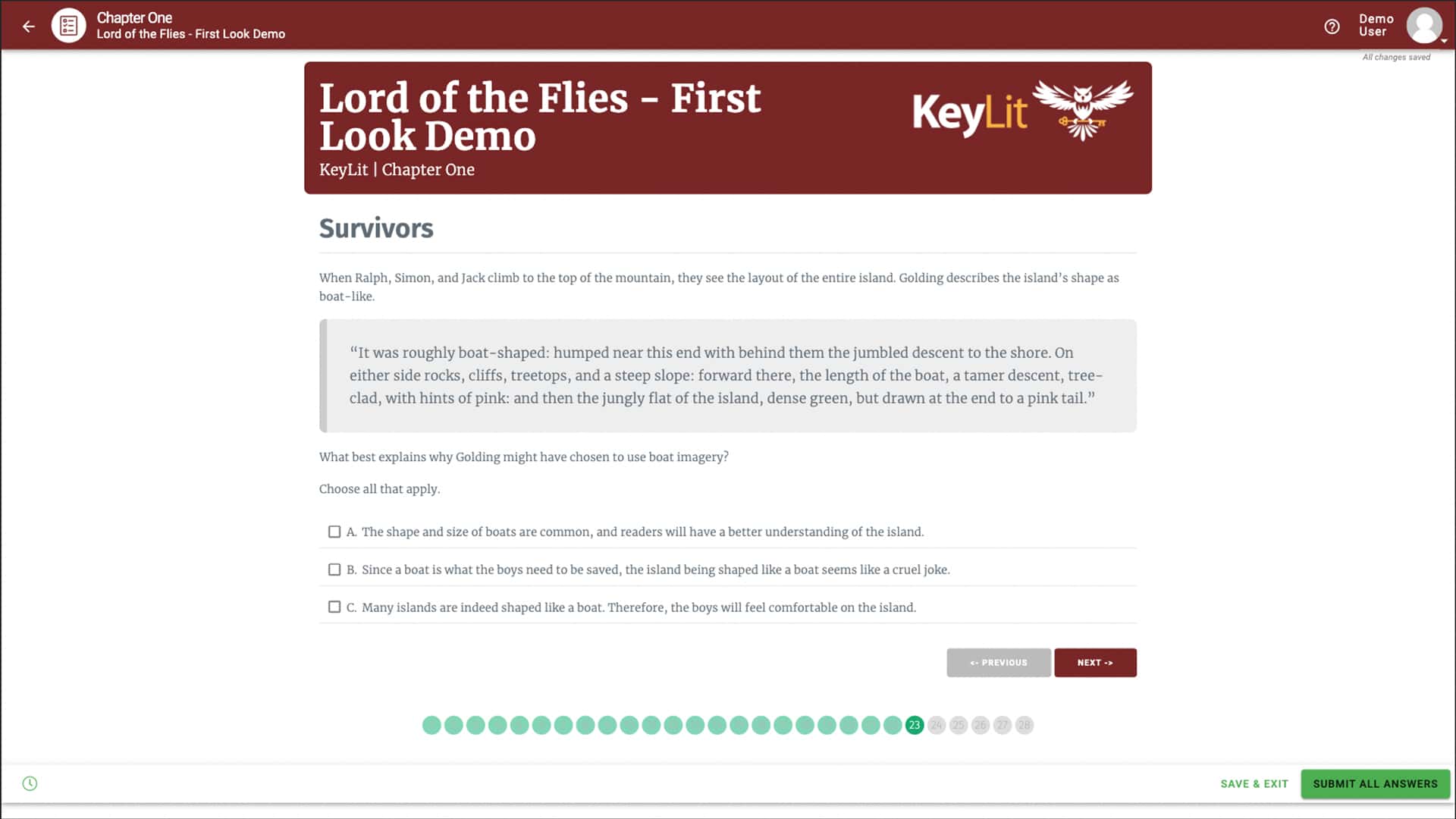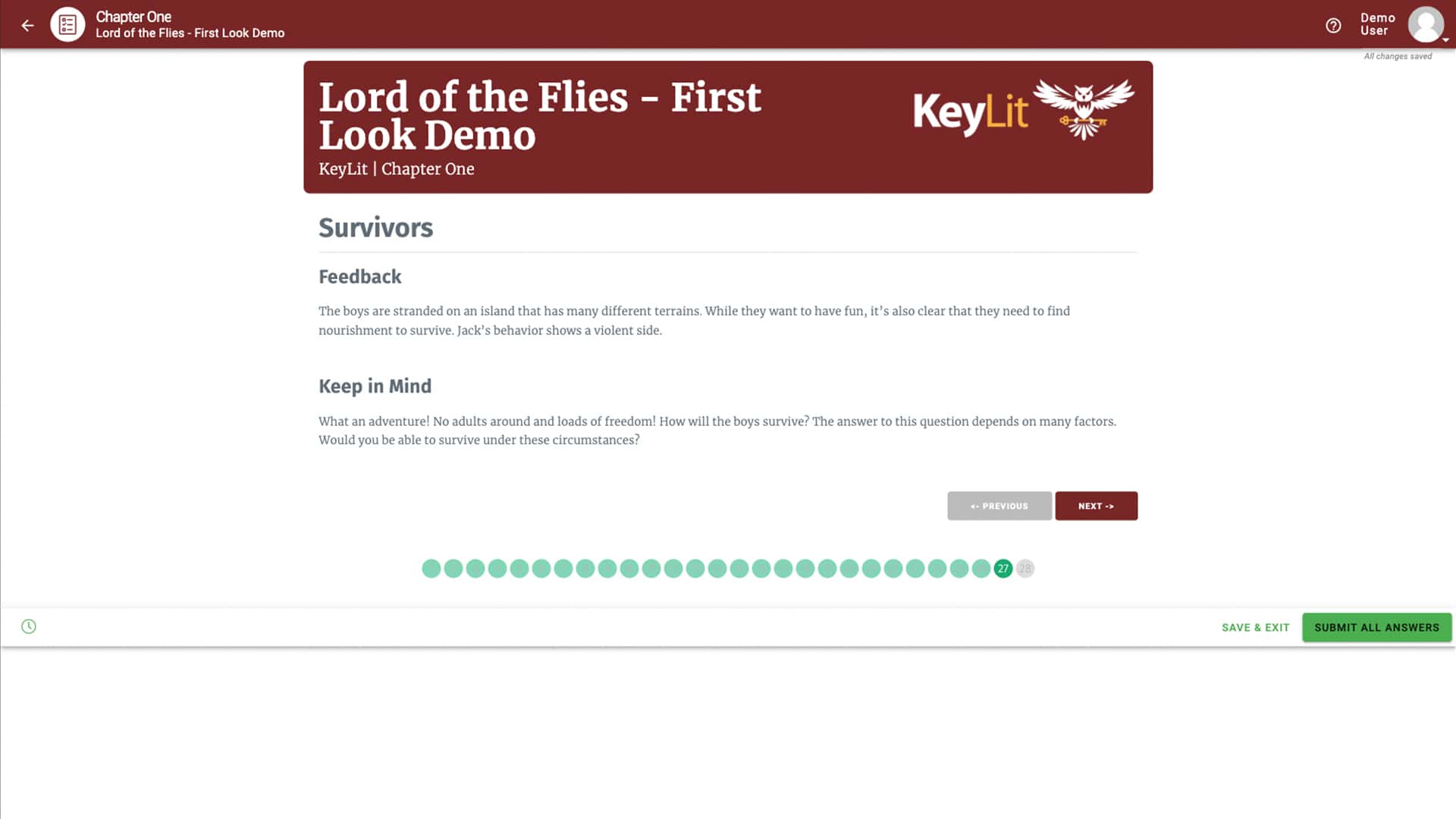Are you ready to try a new way of teaching the literature you love? New from Prestwick House, KeyLit merges standards-based learning with the flexibility of modern tech. This fully digital, interactive program improves students' critical reading skills while helping them connect to and appreciate great works of literature.
Every title-specific KeyLit Literature Companion divides the book into multiple lessons, guiding students through a close reading of the text. Lessons should take approximately 20 to 30 minutes to complete and are perfect for both in-class and at-home work. Each lesson includes:
- Keys to the Lesson, a standards-aligned list of skills that students will work on during the lesson
- Warm-up, a question to activate student knowledge
- Comprehension Questions to scaffold and assess student knowledge of the reading materials
- Close Reading Questions to get students thinking deeply about what makes literature great
- Feedback that encourages students to not only understand the content, but also turn it into knowledge they can use in the future
- Key Takeaways to wrap up the lesson and lock in learning
Now, let's see a KeyLit literature lesson in action! Below, you'll find excerpts from the first KeyLit lesson for William Golding's classic, Lord of the Flies. In each section, members of the KeyLit development team share their thoughts on the program's creation process and offer insight on how the KeyLit lesson structure helps students dive into deeper literary analysis.

Even before class began, I would have students asking me what we were doing that day. Students like to know what they're going to be doing. So, just like in the classroom, KeyLit begins with an overview of objectives. The title of the text and the reading assignment are identified in the very first part. A bulleted list indicates the anchor standards addressed in the lesson.
—Amy T., Curriculum Developer

To get students thinking, I would generally begin the class with a warm-up activity. Maybe it was a quote from the book we were currently reading, or maybe a theme topic from the text. And then for a few minutes, we discussed the big ideas based on the warm-up.
KeyLit follows this same approach. The warm-up question engages students by making connections between the text and an image, quotation, or other relevant ideas. Sometimes, they will be introduced to a new concept, theme, or background context for the novel you're working on. In most cases, this is an opinion-based question, providing students a chance to share their thoughts or ideas.
—Amy T.
Students need to relate to what they're reading to get invested in the story. A warm-up focusing on the major themes or introducing a new concept in a fun way will help them dive right in. We focused on creating engaging, thoughtful ideas that embody the more important concepts of a chapter. Once they have given their opinion, students will have greater investment in the characters they are about to analyze.
—Anna L., Curriculum Developer

Did the students read the assignment? This question will check that! After the warm-up, students will have a chance to see how well they remembered the reading. This comprehension question focuses on key plot events or characters from the assigned reading.
—Amy T.
As a teacher, I couldn't stand creating reading quizzes'but with KeyLit, you won't have to. Each lesson comes with the Main Events, which are comprehension questions designed to assess if your students have read. They also provide a great review of the major plot points before students have to deepen their analysis.
—Anna L.

Whole class discussions are great. No doubt about that! But making sure each and every student understands a book doesn't always happen in discussions. Some students would remain quiet, while a few vocal students participated.
With KeyLit, each student has an opportunity to interact with the text. For students who have read the book and for those who didn't, these questions provide a chance to analyze characters, plot structure, themes, and author's purpose.
A variety of question types keeps the students alert and engaged. Question types include multiple-choice, matching, ordering, and true/false. There are also multiple-answer question types. Sometimes, there is more than one way to interpret a quotation, and multiple-answer questions allow students to think through all the interpretations the author intended.
—Amy T.

Some years when I taught, I'd have 180 students. Providing immediate feedback was next to impossible. But KeyLit gives feedback instantly! After each set of questions, two separate passages provide students with feedback and insight. Feedback reviews the correct answers from the previous exercises and summarizes key points of that series of questions. Keep in Mind includes any new skill or device that has been introduced through the questions. Definitions for literary terms, such as figurative language, rhetorical devices are part of Keep in Mind.
—Amy T.

This section summarizes the main plot events and will include a quick review of terms. The Developing Ideas section focuses on themes, as well as ideas that encourage students to predict or have something to look forward to.
Have students take notes on these sections, to walk away with a clear summary of important analysis they can use for essays, discussions, or tests.
—Anna L.
Want to preview this sample lesson for yourself? Register for a free trial account to walk through this entire sample lesson for Lord of the Flies and get a firsthand look at the interactive KeyLit platform!
KeyLit
Connect students to the literature you love to teach with KeyLit by Prestwick House! This interactive program uses standards-aligned lessons to guide students through close readings of famous works of literature, helping them develop critical reading and analytical skills along the way.
Learn More